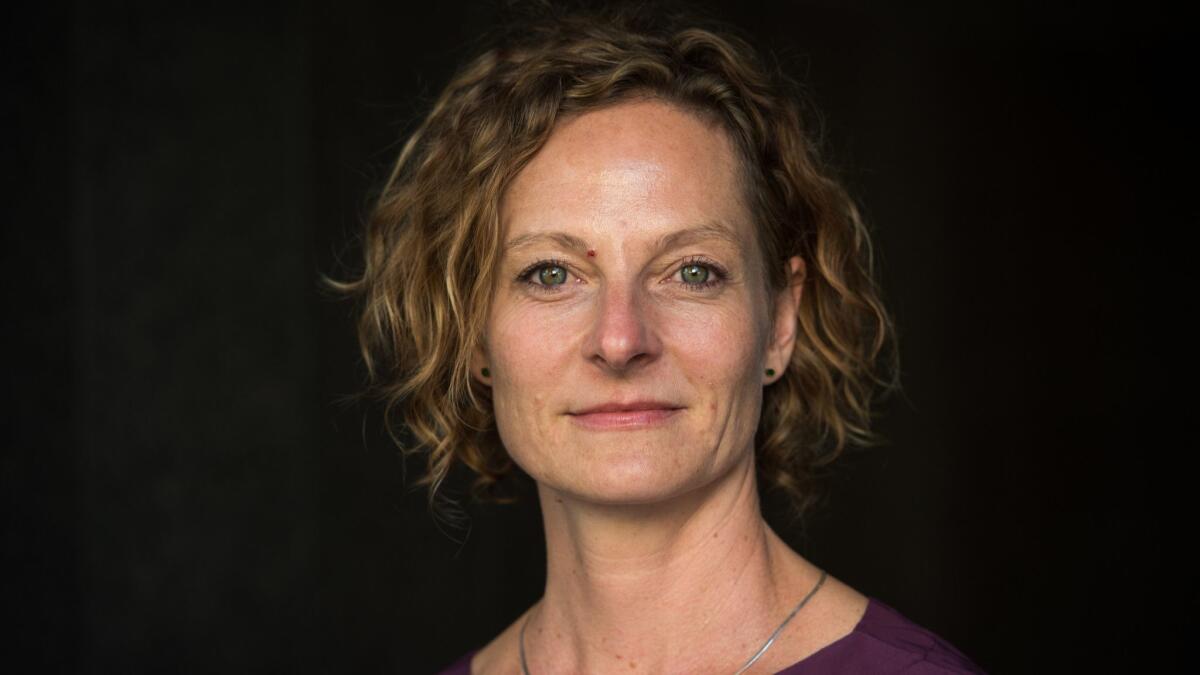In the Hammer Museum’s ‘Made in L.A.’ biennial, dance moves back into the picture
- Share via
The Hammer Museum’s “Made in L.A.” biennial opens Sunday, and among the 32 artists in the show are two experimental dancer-choreographers known for their work in alternative spaces.
Flora Wiegmann and taisha paggett fit right into the mix, curators said, considering that the body and body movement turned out to be important topics in this year’s “Made in L.A.”
“Having dancers in the space and having movement shown is very much in dialogue with other artists in the show,” said Hammer senior curator Anne Ellegood, who selected Wiegmann and paggett with assistant curator Erin Christovale.
But dance does have special requirements, including the need for a changing room and a place to warm up. And because the dancers don’t perform every day, the Hammer has given paggett and Wiegmann gallery space to create related visual installations for museum-goers who might otherwise miss their contributions to the show.
For decades, experimental dancers have had a special niche in art galleries, but the practice is on an upswing at museums.
The Whitney in Manhattan and the Walker Art Center in Minneapolis are just two of the important visual arts spaces where dance has a regular profile. At the 2016 “Made in L.A.,” choreographer Adam Linder won the equivalent of the “best in show” prize, the $100,000 Mohn Award.
Paggett and Wiegmann expressed optimism at the greater inclusion of dance in the art world. But they also sounded a cautionary note.
“I’m glad to see more people doing projects in galleries,” said Wiegmann, who last year was artist in residence at the El Segundo Museum. “There are people that have such deep practices, that I’m hoping dance gets given the space [it deserves] and is not just presented as a special event.”
Said paggett, who was in the 2014 Whitney Biennial: “I think it’s not a good thing if it’s just an art trend and in five years everybody is not going to think about dance, but is thinking about sound art.”
Paggett’s work, titled “Counts Orchestrate, a Meadow (or Weekly Practice With Breath),” references a multitude of topics, including jazz improvisation, the deaths of African Americans and the creative dance process. She wanted her installation to be what she called a space of comfort, so the gallery will have carpeting and soft theatrical lighting to create a sort of interior meadow, and there will be audio tracks of breathing, made by other dancers.
Paggett’s three performances (two solos and one duet with Meena Murugesan) will take place in the galleries. But she might also exit the museum and perhaps walk around the block. If people follow her, well, that’s OK, she said.
“I’m hoping that my body becomes just another operating engine moving alongside the show, but that will be a choice the people make,” said paggett, who in addition to her active performance schedule is an assistant professor at UC Riverside.
Wiegmann’s installation consists of a six-channel video that displays different sections of her 30-minute dance, “Reduction Burn.” Five women (including Wiegmann) will perform in the Hammer’s Nimoy Studio, with the audience seated along two sides. Wiegmann’s dance took shape as a response to personal and political crises. She chose the natural cycle of a forest fire as an allegory for the “flare-ups” she was experiencing, with new life and hope bursting forth from devastation.
“I don’t care if people get exactly what I’m thinking,” said Wiegmann, who is a co-owner of the Mandrake Bar, an artist hangout in Culver City. “I try not to be didactic. It’s not ‘My dance is about A.’ It’s usually about a bunch of different things.”

Both women, who have MFA degrees from UCLA, took very different routes to becoming professional dancers. Weigmann started ballet at 8 near her childhood home in Nebraska, while paggett was 18 when she took her first modern dance class at UC Santa Cruz, where she majored in art history. But their impetus to abandon the traditional theater space derives from a similar skepticism of the status quo.
“I spent years in Chicago and New York, dancing on stages and … honestly I got really frustrated performing the same thing over and over and over,” Wiegmann said, adding that she likes being “in the same space as my audience, and I like them to be on the same level. I feel it democratizes dance.”
Paggett suggested that because she began her training relatively late, she brought to it an adult’s critical eye.
“I think of all of the dance conventions and what I’m supposed to do in a space and what I’m supposed to do with my time and my body, and my first impulse is to go against it. That’s a foundation. I started making work out of a desire to push up against these conventions in dance.”
♦ ♦ ♦ ♦ ♦ ♦ ♦ ♦ ♦ ♦
‘Made in L.A. 2018’
Where: Hammer Museum, 10899 Wilshire Blvd., Los Angeles
When: Sunday-Sept. 2. Wiegmann live events at 2 p.m. June 17, 7 p.m. June 22, 2:30 and 4 p.m. July 15, and 7 p.m., Aug. 22. Paggett live events at 3 p.m. June 17, noon-4 p.m., July 8 and Sept. 1
Information: (310) 443-7000 or hammer.ucla.edu
See all of our latest arts news and reviews at latimes.com/arts.
ALSO:
The guide to dance in L.A.: 12 standout companies to know
‘The Color Purple’ national tour turns down the wattage
‘One Flew Over the Cuckoo’s Nest’: Mingle with the patients before the drama really begins
More to Read
The biggest entertainment stories
Get our big stories about Hollywood, film, television, music, arts, culture and more right in your inbox as soon as they publish.
You may occasionally receive promotional content from the Los Angeles Times.









